fuel pressure Lexus IS250 2006 Other Functions / LEXUS 2006 IS350/250 FROM MAY 2006 PROD. OWNER'S MANUAL (OM53619U)
[x] Cancel search | Manufacturer: LEXUS, Model Year: 2006, Model line: IS250, Model: Lexus IS250 2006Pages: 437, PDF Size: 11.01 MB
Page 7 of 437
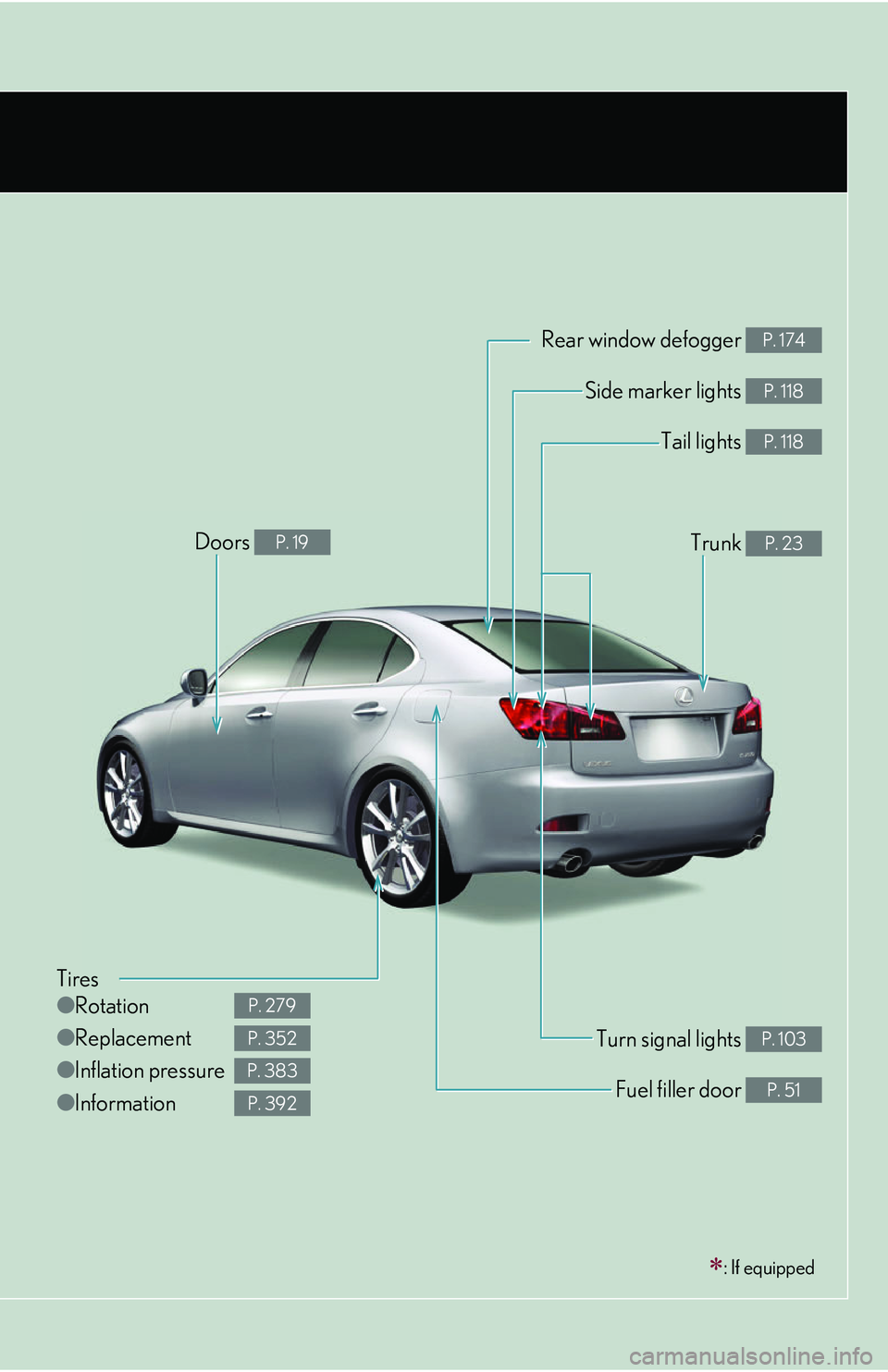
Tires
●Rotation
● Replacement
● Inflation pressure
● Information
P. 279
P. 352
P. 383
P. 392
: If equipped
Tail lights P. 118
Side marker lights P. 118
Trunk P. 23
Rear window defogger P. 174
Doors P. 19
Fuel filler door P. 51
Turn signal lights P. 103
Page 266 of 437

248
4-1. Maintenance and care
Cleaning and protecting the vehicle exterior
■Automatic car washes
●Fold the mirrors back before washing the vehicle.
●Brushes used in automatic car washes may scratch the vehicle surface and
harm your vehicle’s paint.
■High pressure automatic car washes
Do not allow the nozzles of the car wash to come within close proximity of the win-
dows. Before entering an automatic car wash, check that the fuel filler door on your
vehicle is closed properly.
■Aluminum wheels
Remove any dirt immediately by using a neutral detergent. Do not use hard brushes
or abrasive cleaners. Do not use strong or harsh chemical cleaners. Use the same
mild detergent and wax as used on the paint.
■Bumpers and side moldings
Do not scrub with abrasive cleaners.
Perform the following to protect the vehicle and maintain it in prime condi-
tion.
● Working from top to bottom, liber ally apply water to the vehicle
body, wheel wells and underside of the vehicle to remove any dirt
and dust.
Wash the vehicle body using a sponge or soft cloth, such as a
chamois.
● For hard-to-remove marks, use car wash soap and rinse thor-
oughly with water.
● Wipe away any water.
● Wax the vehicle when the waterproof coating deteriorates.
If water does not bead on a clean surface, apply wax when the vehicle
body is cool.
Page 278 of 437
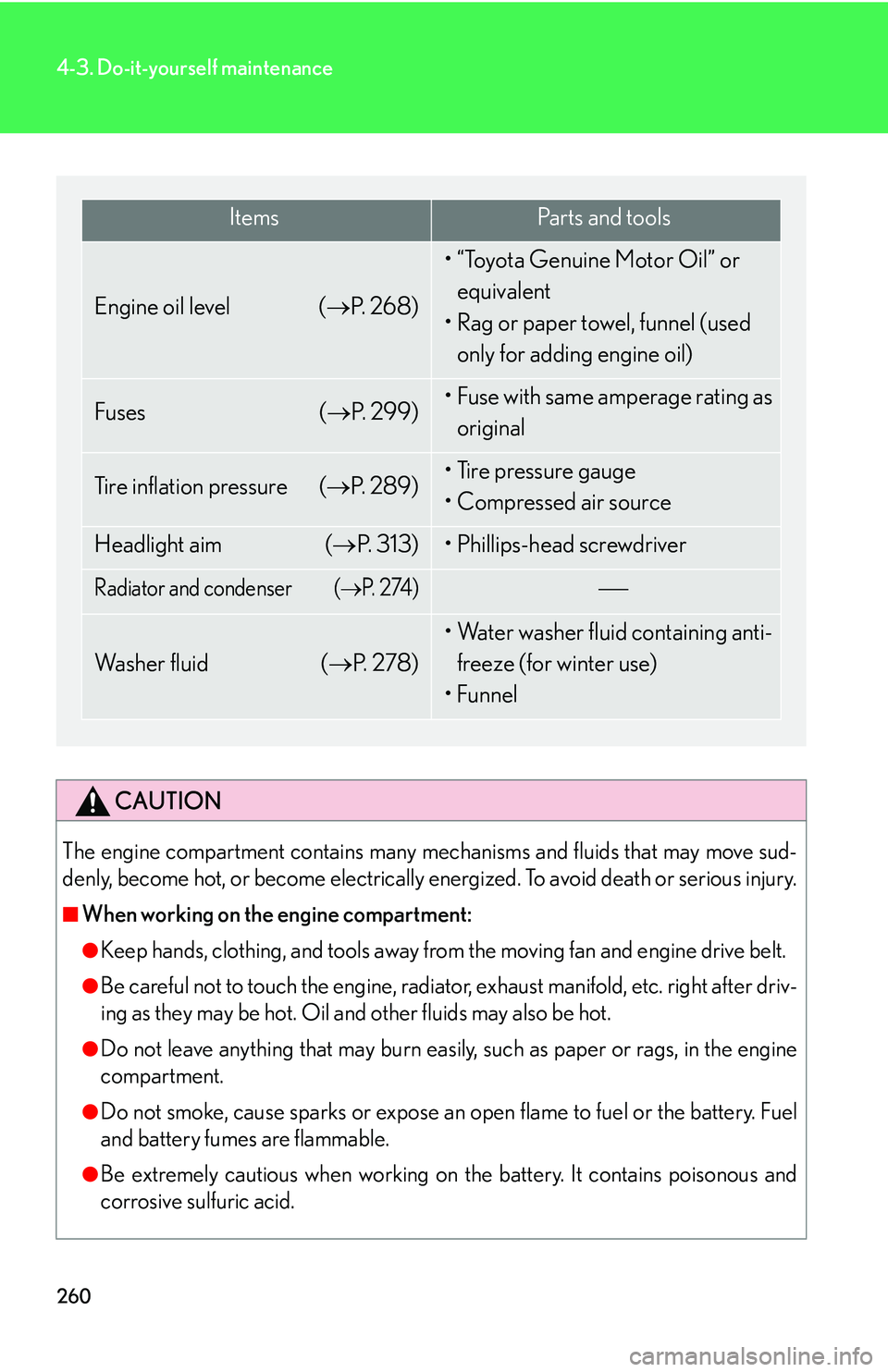
260
4-3. Do-it-yourself maintenance
CAUTION
The engine compartment contains many mechanisms and fluids that may move sud-
denly, become hot, or become electrically energized. To avoid death or serious injury.
■When working on the engine compartment:
●Keep hands, clothing, and tools away from the moving fan and engine drive belt.
●Be careful not to touch the engine, radiator , exhaust manifold, etc. right after driv-
ing as they may be hot. Oil and other fluids may also be hot.
●Do not leave anything that may burn easi ly, such as paper or rags, in the engine
compartment.
●Do not smoke, cause sparks or expose an open flame to fuel or the battery. Fuel
and battery fumes are flammable.
●Be extremely cautious when working on the battery. It contains poisonous and
corrosive sulfuric acid.
ItemsPa r t s a n d t o o l s
Engine oil level ( P. 2 6 8 )
• “Toyota Genuine Motor Oil” or
equivalent
• Rag or paper towel, funnel (used only for adding engine oil)
Fuses ( P. 2 9 9 )• Fuse with same amperage rating as
original
Tire inflation pressure ( P. 2 8 9 )• Tire pressure gauge
• Compressed air source
Headlight aim ( P. 3 1 3 )• Phillips-head screwdriver
Radiator and condenser (P. 2 74 )
Wa s h e r f l u i d (P. 2 7 8 )
• Water washer fluid containing anti-
freeze (for winter use)
•Funnel
Page 309 of 437

291
4-3. Do-it-yourself maintenance
4
Maintenance and care
■Effects of incorrect tire inflation pressure
Driving with incorrect tire pressure may result in the following:
●Reduced fuel efficiency
●Reduced driving comfort and tire life
●Reduced safety
●Damage to the drive train
If a tire needs frequent refilling, have it checked by your Lexus dealer.
■Instructions for checking tire pressure
When checking tire inflation pressure, observe the following:
●Check only when the tires are cold.
If your vehicle has been parked for at least 3 hours and has not been driven for
more than 1 mile or 1.5 km, you will get an accurate cold tire inflation pressure
reading.
●Always use a tire pressure gauge.
The appearance of the tire can be misleadi ng. In addition, tire inflation pressures
that are even just a few pounds off can degrade ride and handling.
●Do not bleed or reduce tire inflation pressure after driving. It is normal for the
tire inflation pressure to be higher after driving.
●Never exceed the vehicle capacity weight.
Passengers and luggage weight should be placed so that the vehicle is bal-
anced.
Page 366 of 437
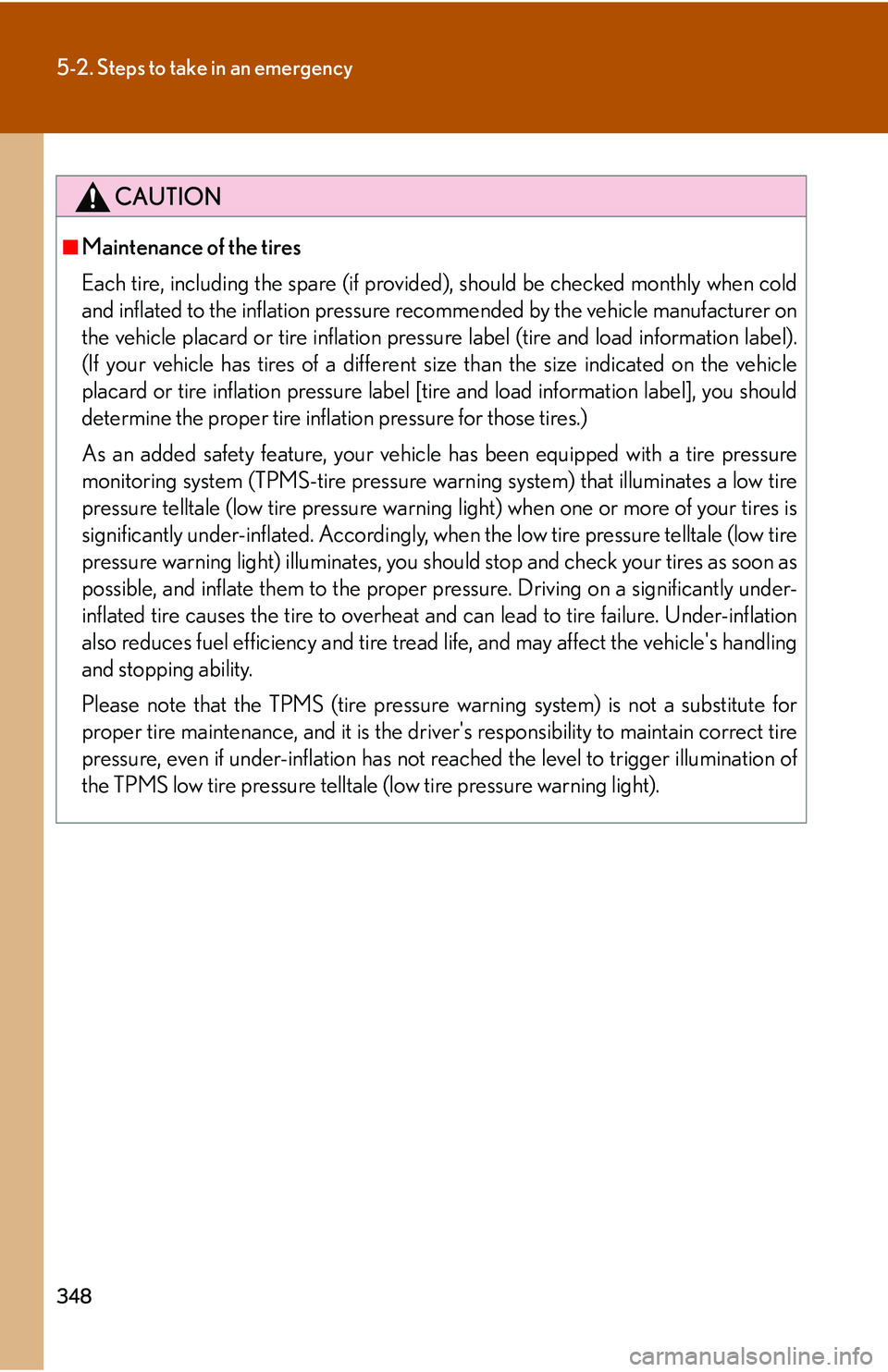
348
5-2. Steps to take in an emergency
CAUTION
■Maintenance of the tires
Each tire, including the spare (if provided), should be checked monthly when cold
and inflated to the inflation pressure re commended by the vehicle manufacturer on
the vehicle placard or tire inflation pressu re label (tire and load information label).
(If your vehicle has tires of a different size than the size indicated on the vehicle
placard or tire inflation pressure label [tire and load information label], you should
determine the proper tire inflation pressure for those tires.)
As an added safety feature, your vehicl e has been equipped with a tire pressure
monitoring system (TPMS-tire pressure warning system) that illuminates a low tire
pressure telltale (low tire pressure warning light) when one or more of your tires is
significantly under-inflated. Accordingly, when the low tire pressure telltale (low tire
pressure warning light) illuminates, you shou ld stop and check your tires as soon as
possible, and inflate them to the proper pressure. Driving on a significantly under-
inflated tire causes the tire to overheat and can lead to tire failure. Under-inflation
also reduces fuel efficiency and tire tread life, and may affect the vehicle's handling
and stopping ability.
Please note that the TPMS (tire pressure warning system) is not a substitute for
proper tire maintenance, and it is the driv er's responsibility to maintain correct tire
pressure, even if under-inflation has not reached the level to trigger illumination of
the TPMS low tire pressure telltale (low tire pressure warning light).
Page 415 of 437
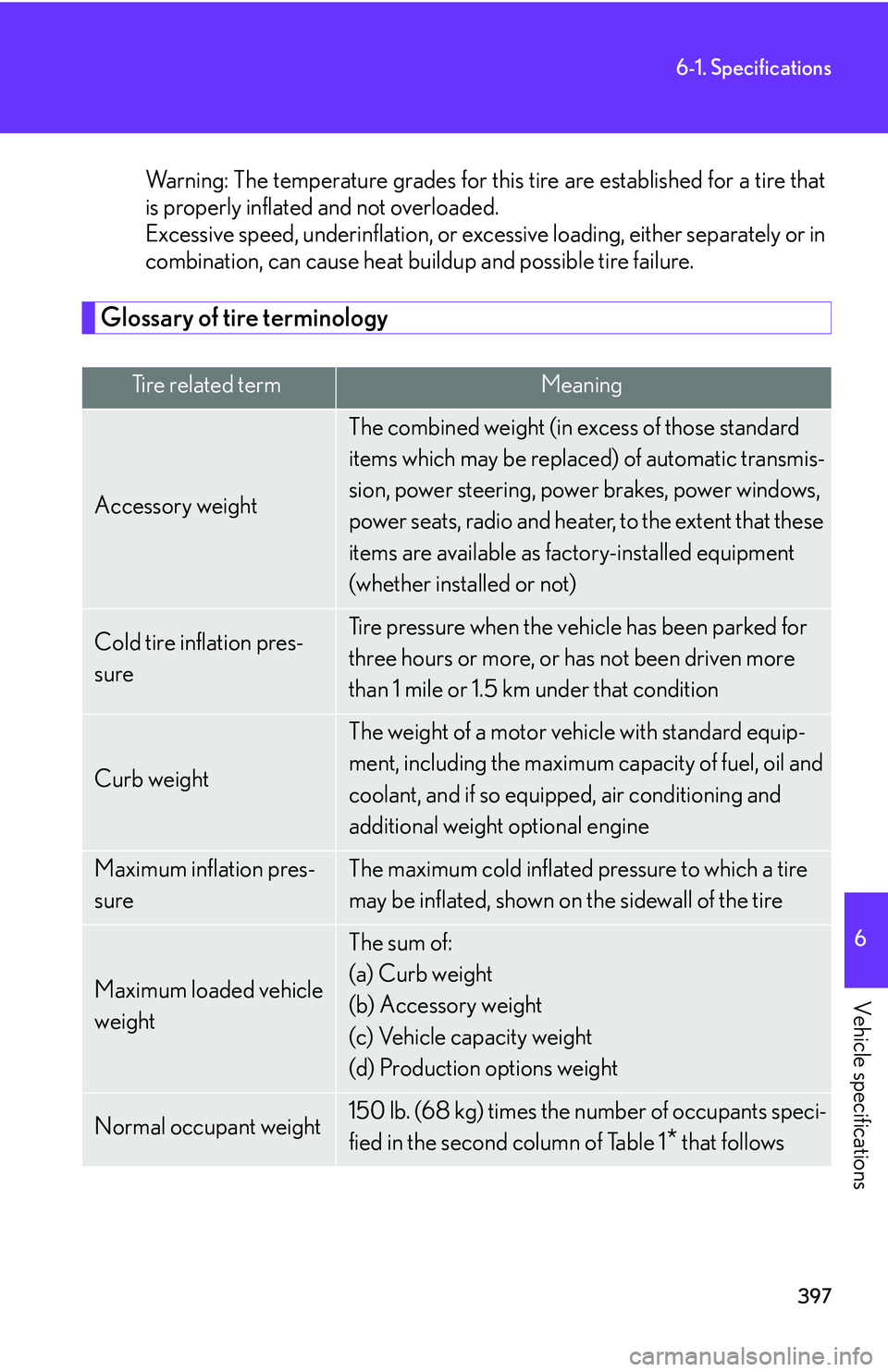
397
6-1. Specifications
6
Vehicle specifications
Warning: The temperature grades for this tire are established for a tire that
is properly inflated and not overloaded.
Excessive speed, underinflation, or excessive loading, either separately or in
combination, can cause heat build up and possible tire failure.
Glossary of tire terminology
Tire related termMeaning
Accessory weight
The combined weight (in excess of those standard
items which may be replaced) of automatic transmis-
sion, power steering, power brakes, power windows,
power seats, radio and heater, to the extent that these
items are available as factory-installed equipment
(whether installed or not)
Cold tire inflation pres-
sureTire pressure when the vehicle has been parked for
three hours or more, or has not been driven more
than 1 mile or 1.5 km under that condition
Curb weight
The weight of a motor vehicle with standard equip-
ment, including the maximum capacity of fuel, oil and
coolant, and if so equipped, air conditioning and
additional weight optional engine
Maximum inflation pres-
sureThe maximum cold inflated pressure to which a tire
may be inflated, shown on the sidewall of the tire
Maximum loaded vehicle
weight
The sum of:
(a) Curb weight
(b) Accessory weight
(c) Vehicle capacity weight
(d) Production options weight
Normal occupant weight150 lb. (68 kg) times the number of occupants speci-
fied in the second column of Table 1
* that follows
Page 433 of 437
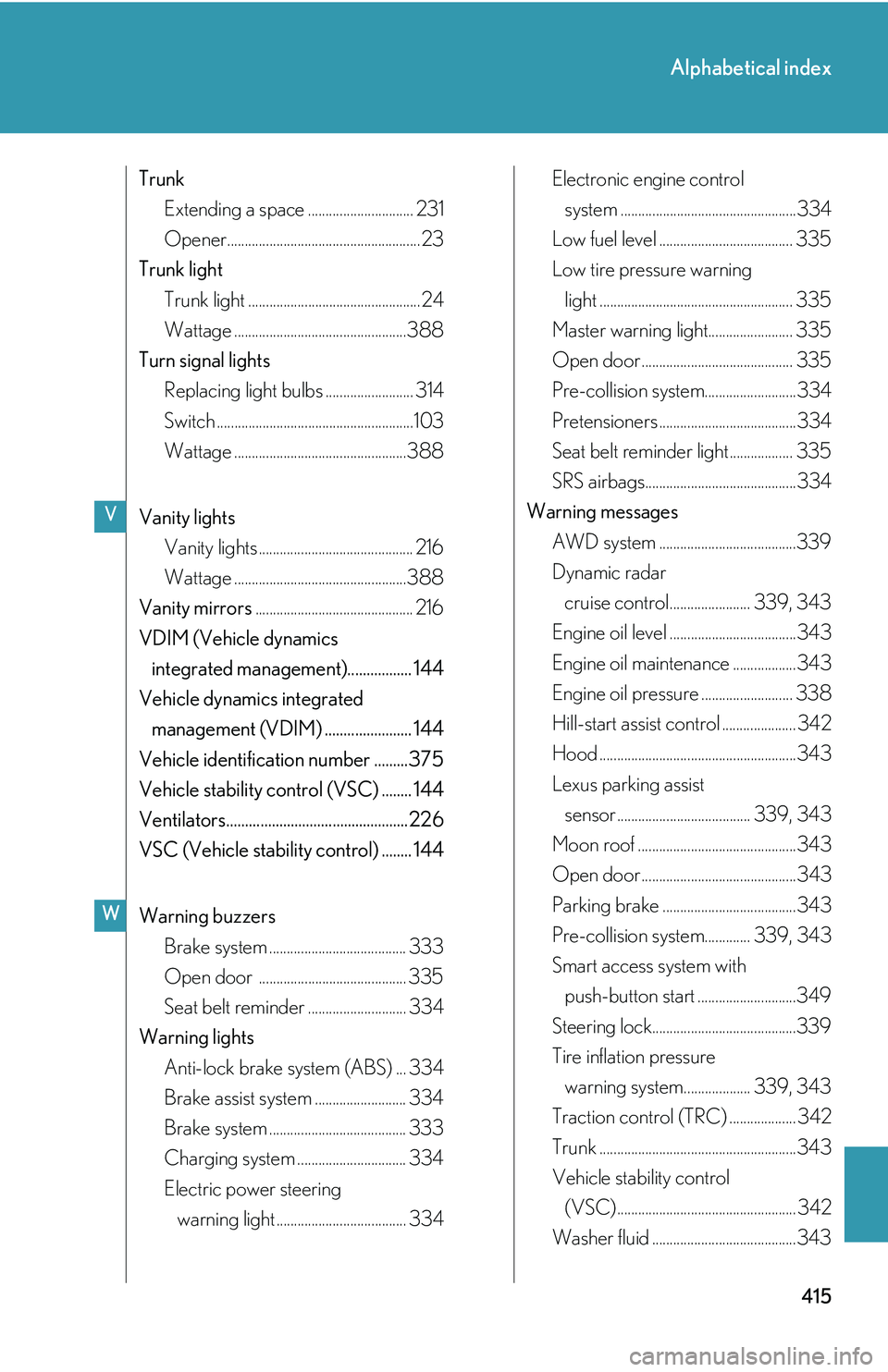
415
Alphabetical index
TrunkExtending a space .............................. 231
Opener.......................................................23
Trunk light Trunk light ................................................. 24
Wattage .................................................388
Turn signal lights Replacing light bulbs ......................... 314
Switch ........................................................103
Wattage .................................................388
Vanity lights Vanity lights ............................................ 216
Wattage .................................................388
Vanity mirrors ............................................. 216
VDIM (Vehicle dynamics integrated managem ent)................. 144
Vehicle dynamics integrated management (VDIM) ....................... 144
Vehicle identification number .........375
Vehicle stability control (VSC) ........ 144
Ventilators................................................226
VSC (Vehicle stability control) ........ 144
Warning buzzers Brake system ....................................... 333
Open door .......................................... 335
Seat belt reminder ............................ 334
Warning lights Anti-lock brake system (ABS) ... 334
Brake assist system .......................... 334
Brake system ....................................... 333
Charging system ............................... 334
Electric power steering warning light ..................................... 334 Electronic engine control
system ..................................................334
Low fuel level ...................................... 335
Low tire pressure warning light ....................................................... 335
Master warning light........................ 335
Open door ........................................... 335
Pre-collision system..........................334
Pretensioners .......................................334
Seat belt reminder light.................. 335
SRS airbags...........................................334
Warning messages AWD system .......................................339
Dynamic radar cruise control....................... 339, 343
Engine oil level ....................................343
Engine oil maintenance ..................343
Engine oil pressure .......................... 338
Hill-start assist control ..................... 342
Hood ........................................................343
Lexus parking assist sensor ...................................... 339, 343
Moon roof .............................................343
Open door ............................................343
Parking brake ......................................343
Pre-collision system............. 339, 343
Smart access system with push-button start ............................349
Steering lock.........................................339
Tire inflation pressure warning system................... 339, 343
Traction control (TRC) ................... 342
Trunk ........................................................343
Vehicle stability control (VSC)................................................... 342
Washer fluid .........................................343
V
W
Page 436 of 437

418
What to do if...
The warning light or indicator
light comes onP. 3 3 3If the warning light turns on
■Warning lights
or or
P. 333P. 3 3 4
P. 3 3 5
or
P. 3 3 4P. 3 3 5
P. 335P. 3 3 5
P. 3 3 4P. 3 3 4
P. 335P. 3 3 4
P. 3 3 4P. 3 3 5
Brake system warning lightMalfunction indicator lamp
“ABS” warning lightDriver’s seat belt reminder
light
Front passenger’s seat belt
reminder light
Low fuel level warning lightMaster warning light
SRS warning lightElectric power steering warning
light
Open door warning lightPre-collision safety system
warning light
Charging system warning
lightLow tire pressure warning
light
The warning message is dis-
playedP. 3 3 8If the warning message is displayed
Page 437 of 437
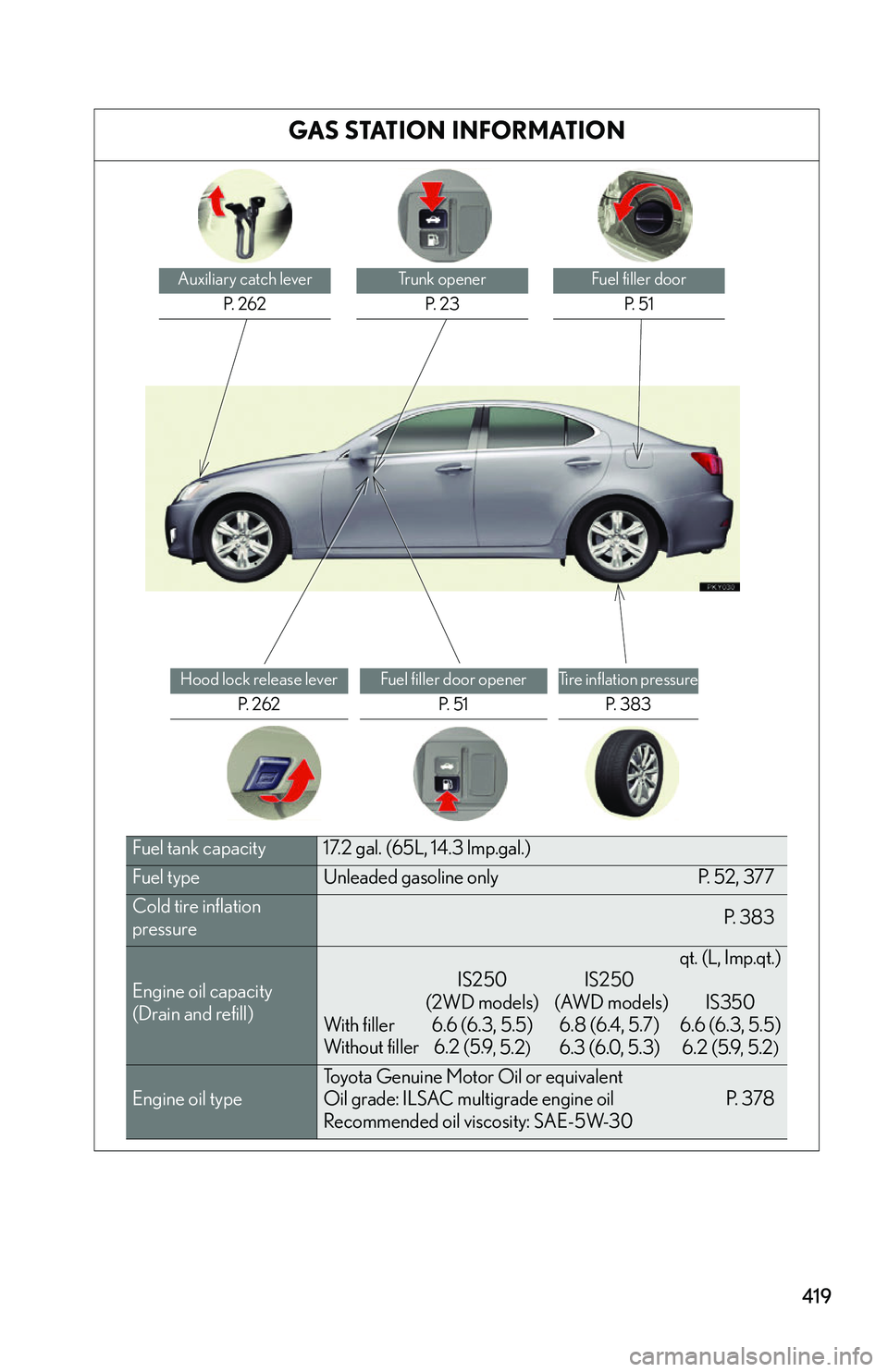
419
GAS STATION INFORMATION
Auxiliary catch leverP. 2 6 2Trunk openerP. 2 3Fuel filler door P. 5 1
Hood lock release lever P. 2 6 2Fuel filler door opener P. 5 1Tire inflation pressureP. 3 8 3
Fuel tank capacity17.2 gal. (65L, 14.3 lmp.gal.)
Fuel typeUnleaded gasoline only P. 52, 377
Cold tire inflation
pressureP. 3 8 3
Engine oil capacity
(Drain and refill)
qt. (L, Imp.qt.)
IS250 IS250
(2WD models) (AWD models) IS350
With filler 6.6 (6.3, 5.5) 6.8 (6.4, 5.7) 6.6 (6.3, 5.5)
Without filler 6.2 (5.9
, 5.2)6.3 (6.0, 5.3) 6.2 (5.9, 5.2)
Engine oil type
Toyota Genuine Motor Oil or equivalent
Oil grade: ILSAC multigrade engine oil P. 378
Recommended oil viscosity: SAE-5W-30